Regular Pyramid
A regular pyramid is one whose base is a regular polygon whose center coincides with the foot of the perpendicular dropped from the vertex to the base.
Properties of a Regular Pyramid
 The edges of a regular pyramid are equal; it is denoted by e.
The edges of a regular pyramid are equal; it is denoted by e.- The lateral faces of a regular pyramid are congruent isosceles triangles (see figure).
- The altitudes of the lateral faces of a regular pyramid are equal. It is the slant height of the regular pyramid and is denoted by L.
- The altitude of the regular pyramid is perpendicular to the base. It is equal to length of the axis and is denoted by h.
- The vertex of regular pyramid is directly above the center of its base when the pyramid is oriented as shown in the figure.
- If a cutting plane is passed parallel to the base of regular pyramid, the pyramid cut off is a regular pyramid similar to the original pyramid.
Formula for regular pyramid
$A_b = \dfrac{n}{2}xr$
$A_b = \dfrac{n}{2}R^2 \sin \theta$
For more information about the two formulas above, see The Regular Polygon.
$A_1 = xL$
$A_L = nA_1$
$A_L = \dfrac{n}{2}xL$
$A_L = \dfrac{PL}{2}$
$A_T = A_b + A_L$
$e = \sqrt{R^2 + h^2}$
$L = \sqrt{r^2 + h^2}$
$L = \sqrt{e^2 - (x/2)^2}$
$V = \frac{1}{3}A_b \, h$
$V = \dfrac{n}{6}xr \, h$
$V = \dfrac{n}{6}R^2h \, \sin \theta$
Ab = area of the base (regular polygon)
A1 = area of one lateral face
AL = lateral area
AT = total area
x = length of side of the base
h = altitude of pyramid (this is the length of axis of the pyramid)
L = slant height of pyramid (this is the altitude of triangular face)
P = perimeter of the base
e = length of lateral edge
For x, R, r, n, and θ, see The Regular Polygon.
Tags
- Log in to post comments
